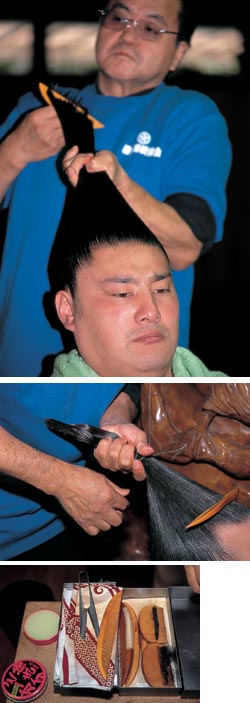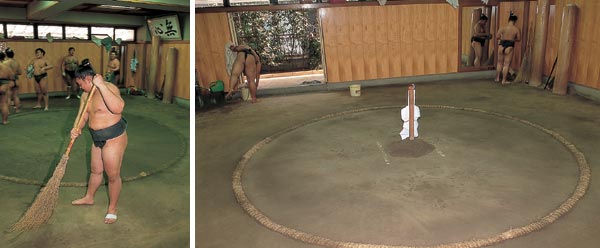 |
The tokoyama hairdresser skillfully arranges the hair of each rikishi into the chonmage style. He uses special scissors, combs and oil (below), and fastens the hair in two places with a motoyui cord made from washi paper (center).
|
|
Life at a stable is like living in a big family. The stable master (oyakata) is the "father." During practice training sessions he sits on the front side of the ring and gives strict instructions. His wife, the "mother," is called okami-san. She is a pillar of support to the young wrestlers and is ready to give them advice on how to deal with life's problems. The wrestlers treat each other according to how long they have been at the stable. The older ones, called ani-deshi, show their underlings (ototo-deshi) the ropes and expect a certain degree of subservience from them. All rikishi in this "family" learn and practice long-established forms of courtesy.
Of course, the world of sumo is a world of competition. Rikishi rise or fall through the ranks depending on their performance in the tournaments. Rankings, beginning with the lowest and moving up in order, are: jonokuchi, jonidan, sandanme, makushita and the maku-uchi group. The maku-uchi group includes these ranks: working upwards, juryo, maegashira, komusubi, sekiwake, ozeki and yokozuna. Wrestlers up to the rank of makushita are called wakamono ("young fellows"), while those in the maku-uchi group are called sekitori. Sekitori receive a monthly salary, but wakamono get only a small allowance. The "young fellows" act as menservants for their superiors, looking after their needs, washing their clothes, waiting on them at mealtime, and tightening their loincloths during a tournament. Wrestlers other than yokozuna can be demoted through the ranks, and an "older brother" could possibly end up being a manservant for a "younger brother"—such an embarrassment, it is assumed, will make him try much harder.
At the Sadogatake Beya stable, the wrestlers are up by 6 a.m. They strip down, even on cold winter days, and put on mawashi loincloths. Then they walk to the training area. The lowest ranking wrestlers are the first on the clay ring (dohyo) to practice. Bodies collide together and sweat pours off. Two types of practice matches are moshiai-geiko (the winner of one round faces off against a challenger in the next), and butsukari-geiko (one wrestler stands ready, the other slams into him and pushes him out of the ring). These rounds alternate, time after time.
After about four hours, the practice ends and they sweep the dohyo ring. They smooth the sandy surface carefully, and then place a gohei rod with paper streamers in the middle of the ring to purify it, because the ring is considered a sacred place. Then they take a bath. Next, one by one, they have their hair arranged by a tokoyama hairdresser. The hair, disarrayed during the practice bouts, is untangled with a comb, fixed in position with a special oil, then fastened with a motoyui cord to complete the impressive chonmage hairstyle.
|


